Feature Article - Experimental estimates of the average age at labour force withdrawal
This article was published in the January 2005 issue of Australian Labour Market Statistics (cat. no. 6105.0).
EXPERIMENTAL ESTIMATES OF THE AVERAGE AGE AT WITHDRAWAL FROM THE LABOUR FORCE
INTRODUCTION
People retire (that is, stop undertaking paid work or stop looking for paid work) for many different reasons. People with access to superannuation, savings, or other sources of income including the aged pension may retire because they no longer want to undertake paid work and can afford to retire. Others may retire involuntarily due to poor health, caring responsibilities, or because they cannot find paid work.
The age at which people retire has become a topic of increased interest in recent years. In 2003, over one third of the Australian population was aged 45 years and over, while it is projected that one half will be in this age group by 2043 (end note 1). If the average retirement age stays the same over time, the labour force may become considerably smaller in number. Alternatively, higher labour force participation by older people (and so later retirement) could counter the effects of demographic change on the labour force (end note 2).
While trends in retirement age are of considerable interest, the age at retirement is not easily measured. People may leave the labour force and then return either to full-time or part-time work in the future, so apparent retirement may not be permanent. Alternatively, retirement may be gradual, when people who retire from a full-time job continue to work part-time or intermittently. This lack of finality in the work-to-retirement transition creates some difficulties in defining and measuring the age at retirement from the labour force.
An ABS Research Paper 'Measuring the Age at Withdrawal from the Labour Force' will be released shortly. The Research Paper will outline the conceptual and methodological issues involved in measuring the age at withdrawal from the labour force, and identify the preferred method for calculating the age at withdrawal.
This article presents the experimental estimates of the average age at withdrawal from the labour force using the preferred method identified in the Research Paper. It also presents some general trends in labour force participation of 45-84 year olds over the past two decades. In this article, age at withdrawal is used as a proxy for age at retirement.
LABOUR FORCE AGED 45-84 YEARS
The analysis in this article focuses on the patterns of labour force participation for men and women aged 45-84 years between 1983 and 2003. The 45-84 year age group was chosen for a number of reasons. Withdrawal from the labour force is more likely to be permanent above the age of 45 than at younger ages, and a number of international studies on labour force withdrawal have used a minimum age of 45 (for examples, see: Scherer (end note 3); Gendel (end note 4); Latulippe (end note 5)). A maximum age of 84 years is used in this article because of the very small numbers of people above this age who participate in the labour force.
Graph 1 shows that labour force participation rates for men and women decline noticeably after the mid-fifties. However, while this trend is consistent, there are a number of changes between 1983 and 2003. In this period, participation for men aged between 45 and 59 years has declined, while participation for men aged between 60 and 74 years has risen. Also in this period, participation rates have increased considerably for women aged between 45 and 64 years.
Graph 1, Labour force participation rates(a)
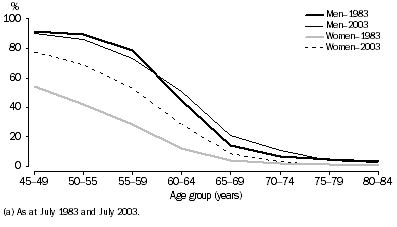
For more information on changes in labour force participation in Australia over the last twenty years, see the article 'Labour Force Participation in Australia' in this (January 2005) issue of Australian Labour Market Statistics (cat. no. 6105.0).
DATA AND METHODS
Data from the Labour Force Survey (LFS) can be used to estimate an average age at which people withdraw from the labour force. This is done by examining periodic changes in the number of people participating in the labour force.
Data from the LFS between 1981 and 2003 have been used to calculate the average age at withdrawal from the labour force by measuring changes in the size of the labour force for single year age cohorts between two periods. The net difference is assumed to be the number of people who have withdrawn from the labour force. If more people have entered than left the labour force between two years, the net difference is set to zero, as there has been no net withdrawal from the labour force. Net differences in the size of the labour force are used because it is not possible to track individual people from year to year using the LFS.
The average age at withdrawal from the labour force is calculated by dividing the total combined ages of all people withdrawing by the total number of people withdrawing over the period (with the number of people withdrawing based on the net differences, as explained above). The following equation describes how the measure is calculated.
For example, if between two years there is a net withdrawal of 1000 people between ages 59 and 60 and 900 people between ages 64 and 65, then the average age at withdrawal will be {(1000*60 + 900*65) / (1000+900)} = 62.4 years.
Using this method, estimates of the average age at withdrawal are made for both the labour force and the full-time labour force. The full-time labour force is the sum of the number of people in full-time employment and the number of unemployed people who are looking for full-time employment.
The estimates described in the results below are three year averages of the average age at withdrawal. This is done to remove volatility in the estimates. The results refer to the middle year in order to indicate the three year time period, so an estimate of the average age at withdrawal for 2002 actually represents the average age at withdrawal for the period 2001 to 2003.
More information on the method for calculating average age at withdrawal is available in the appendix at the end of this article. This appendix also contains a table of the estimated age at withdrawal from the labour force, and the full-time labour force, for men and women from 1983 to 2002.
AVERAGE AGE AT WITHDRAWAL FROM THE LABOUR FORCE
Graph 2 shows the average age at withdrawal for men and women over the period 1983 to 2002. In 2002, the average age at withdrawal for men was 60.3 years. Apart from the period between 1993 and 1997, the average age at withdrawal for men has been fairly stable at around 60 years of age. During the mid-1990s, the average age at withdrawal was lower than this, dropping to 58.6 years in 1996.
Since 1987, the average age at withdrawal for women has followed a similar pattern to that of men, although women appear to withdraw at around two years younger than men. Since 1998 the average age at withdrawal for women has been relatively steady at around 58 years of age.
Graph 2, Average age at withdrawal from the labour force(a)
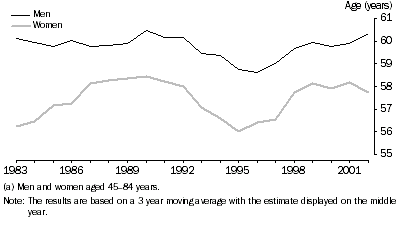
Changes over time in the average age at withdrawal may be influenced by a range of social and economic factors.
Generally, the average age at withdrawal for both men and women appears to follow the economic cycle. During periods of low economic growth, the average age at withdrawal may fall as older people who lose their job and are unable to find a new job may decide to withdraw from the labour force earlier than intended, rather than continue to search for employment. Conversely, during periods of high economic growth, people are less likely to withdraw involuntarily and this may lead to an increase in the average age of withdrawal as people stay in the labour force for longer.
Graph 3 shows unemployment rates for men and women between June 1983 and June 2002. During this period there were two periods of low economic growth in Australia, at around 1983 and 1991, which resulted in periods of high unemployment. The period of low economic growth in the early 1990s, for example, preceded a marked decline in the age at withdrawal of both men and women.
Graph 3, Unemployment rate(a)
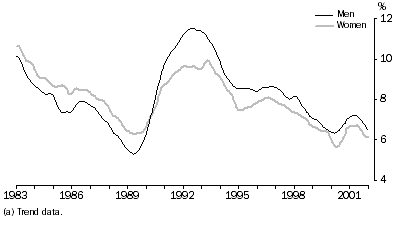
A number of other factors may also influence changes in the age at withdrawal. Social changes, such as a greater general acceptance of women in the workforce, are likely to have contributed to the increase in the participation of women in the labour force in the 1980s, when a marked rise in female labour force participation was accompanied by a rise in the average age at withdrawal for women.
Other factors may include changing expectations of retirement and changes in government policy associated with superannuation and pension benefits.
AVERAGE AGE AT WITHDRAWAL FROM THE FULL-TIME LABOUR FORCE
Graph 4 compares the average age at withdrawal from the labour force with the average age at withdrawal from the full-time labour force. In general, the average age at withdrawal from the full-time labour force follows a similar pattern, though at younger ages, to that of withdrawal from the labour force.
In 1983, the difference between the average age of men withdrawing from the labour force and those withdrawing from the full-time labour force was 0.6 years. It widened to a gap of 1.0 year in 1991, narrowed to a difference of 0.5 years in 1996 and has since then widened again to a difference of 0.9 years in 2002. The gap between withdrawal from the full-time labour force and withdrawal from the labour force shows that some men appear to move from full-time work to part-time work before finally retiring, and this trend has been increasing since the mid-1990s.
The gap between withdrawal from the full-time labour force and the labour force is more variable for women than for men. In 1983, the difference in the average age of women withdrawing from the labour force and those withdrawing from the full-time labour force was 0.9 years, but between 1989 and 1995 the difference narrowed considerably to a low of 0.2 years in 1991. Since 1996, the gap between the age at withdrawal from the full-time labour force and the labour force has increased to more than 1.0 year. In 2001, the difference was 1.6 years.
Graph 4, Average age at withdrawal(a)
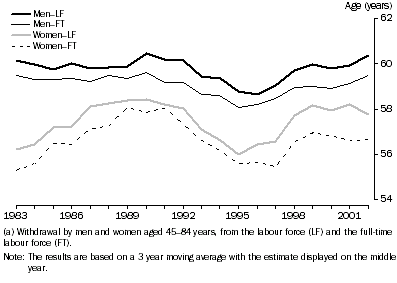
These results suggest that, overall, the proportion of people retiring from the full-time labour force and working part-time before completely retiring has increased over the past 10 years. Graph 5 shows the part-time participation rates of men and women aged 45-84 years in 1983 and in 2003. The part-time participation rate is the number of people working part-time plus the number of unemployed people looking for part-time work, as a proportion of the population.
In 1983, the part-time participation rate of men was very low, between 1.3% (for men aged 75-79 years) and 4.5% (for men aged 65-69 years). By 2003, the proportion of men participating part-time had at least doubled in every age group between 45-49 years and 65-69 years, with men aged 60-64 years having the highest part-time participation (11.8%). The part-time participation of women aged 45-84 years has also increased considerably in all age groups up to 70-74 years.
Graph 5, Part-time labour force participation rates(a)
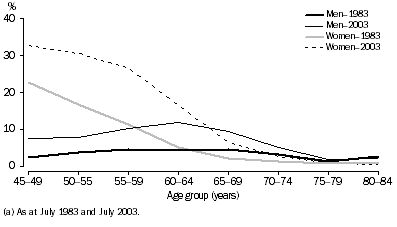
SUMMARY
The experimental estimates provided in this article suggest that the average age at withdrawal is influenced by the economic cycle as well as a number of other factors. Men tend to withdraw from the labour force at a slightly older age than women; however, the gap has been narrowing over the past 10 years, which may be related to women's increased participation, particularly in the older age groups. Since the mid 1990s, the difference between the age at withdrawal from the labour force and the age at withdrawal from full-time participation has widened. This indicates that after withdrawing from full-time employment, more people are entering part-time employment before finally withdrawing from the labour force.
FURTHER INFORMATION
The Research Paper Measuring the Age at Withdrawal from the Labour Force will be available shortly. Any questions about the estimates can be directed to the Assistant Director, Analytical Services Branch on Canberra (02) 6252 6307.
For email enquiries please contact Client Services on client.services@abs.gov.au.
END NOTES
1. ABS Population Projections, Australia 2002-2101, cat. no. 3222.0. < Back
2. Commonwealth Department of Family and Community Services (2003), Inquiry into long-term strategies to address the ageing of the Australian population over the next 40 years: submission to the 2003 House of Representatives Standing Committee on Ageing, Occasional paper, number 8. < Back
3. Scherer, P. (2002) “Age of withdrawal from the labour force in OECD countries”, Labour market and social policy occasional paper, 49, OECD. < Back
4. Gendell, M. (1998) “Trends in retirement age in four countries, 1965-95”, Monthly Labor Review, vol. 121(8). < Back
5. Latulippe, D. (1996) “Effective retirement age and duration of retirement in the industrial countries between 1950 and 1990”, Issues in Social Protection Discussion Paper 2, ILO, Geneva. < Back
APPENDIX - DESCRIPTION OF METHODOLOGY USED TO DERIVE AVERAGE AGE AT WITHDRAWAL FROM THE LABOUR FORCE
INTRODUCTION
The estimates of average age at withdrawal from the labour force presented in this article are derived from differences in the estimated number of people in the labour force at each age in each year, based on data from the Labour Force Survey.
This method of calculating the average age at withdrawal is similar to that used by the Organisation for Economic Co-operation and Development (OECD) in their current series of studies of Ageing and Employment Policies. For more information see the OECD web site, which provides information on these studies: <http://www.oecd.org/department/0,2688,en_2649_34747_1_1_1_1_1,00.html>.
Two other methods were assessed prior to deciding to use the method described here. Both of these alternative methods produced estimates of the expected age at withdrawal, based on the probability of remaining in the labour force for a given period. The alternative methods were more computationally complex and more difficult to interpret. As a result, the current article uses the average age at withdrawal measure. The alternative methods will be explained and compared with this method in a forthcoming Research Paper 'Measuring the Age at Withdrawal from the Labour Force'.
CALCULATION OF THE AGE AT WITHDRAWAL
Method
Data from the LFS have been used to calculate the average age at withdrawal from the labour force by measuring changes in the size of the labour force for single year age cohorts between two years. The net difference is assumed to be the number of people who have withdrawn from the labour force. The average age at withdrawal from the labour force is calculated by dividing the total combined ages of all people withdrawing by the total number of people withdrawing over the period (with the number of people withdrawing being net differences, as explained above). The following equation describes how the measure is calculated.
For example, if between two years there is a net withdrawal of 1000 people between ages 59 years and 60 years and 900 people between ages 64 years and 65 years, then the average age of withdrawal will be {(1000*60 + 900*65) / (1000+900)} = 62.4 years. A more detailed example is provided later.
Using this method, estimates of the average age of withdrawal are made for both the labour force and the full-time labour force. The full-time labour force is the sum of the number of people in full-time employment and the number of unemployed people who are looking for full-time employment.
Annual averages
For each year between 1981 and 2003, the estimated number of people in the labour force was derived by averaging the data over the year.
Ages 45 to 84
The age range for the analysis was restricted to ages 45-84 years - in effect, assuming that withdrawal from the labour force starts at 45 years, and all people have withdrawn by 85 years. Although the situation is not this simple in reality, analysis of participation rates showed that these assumptions are reasonable, with very few people 85 years or older remaining in the labour force.
Net entries
If more people have entered than left the labour force between two years, the net difference (a net entry) is set to zero, as there has been no net withdrawal from the labour force.
With the use of 45 years as the lower age bound, there is the potential that, particularly for younger ages in the range, there could be a net entry rather than a net withdrawal. To include these net entries in the calculation, rather than setting them to zero, would increase the estimated average age at withdrawal, distorting the results. Setting net entries to zeros removes the need to consider increasing the lower age bound.
Net entries are also a potential issue for older age groups, where numbers are very small and so subject to considerable sampling error, resulting in volatility of the estimates from year to year.
Three year averages
The estimates described in the results below are three-year averages of the average age of withdrawal. This is done to remove volatility in the estimates. The results in the article refer to the middle year in order to indicate the three year time period, so an estimate of the average age of withdrawal for 2002 actually represents the average age of withdrawal for the period 2001 to 2003.
DETAILED EXAMPLE
In this example, it is assumed that no one withdraws from the labour force before the age of 55 years, and everyone is retired by age 60.
Table 1, Size of labour force |
|  |
| Age (years) | 2002 | 2003 |  |
|  |
| 55 | 1,000 | 1,000 |  |
| 56 | 700 | 600 |  |
| 57 | 500 | 450 |  |
| 58 | 200 | 175 |  |
| 59 | 50 | 40 |  |
| 60 | 0 | 0 |  |
|  |
Step 1
Calculate the amount of withdrawal between 2002 and 2003 at each age
400 = (1000-600) of the people aged 56 years in 2003 withdraw over the year
250 = (700-450) of the people aged 57 years in 2003 withdraw over the year
325 = (500-175) of the people aged 58 years in 2003 withdraw over the year
160 = (200-40) of the people aged 59 years in 2003 withdraw over the year
50 = (50-0) of the people aged 60 years in 2003 withdraw over the year
Step 2
Multiply the number withdrawing by the age at which they withdrew
(56 × 400) + (57 × 250) + (58 × 325) + (59 × 160) + (60 × 50) = 67940
Step 3
Calculate total number of people withdrawing over the year
400 + 250 + 325 + 160 + 50 = 1185 people withdraw
Step 4
The average age of people withdrawing over the year
RESULTS
Table 2 presents the experimental estimates of the average age at withdrawal from the labour force, and the full-time labour force, using the data and method described above.
Table 2, Average age at withdrawal from the labour force |
|  |
 | From the full-time labour force
| From the labour force
|  |
 | Women | Men | Women | Men |  |
|  |
| 1983 | 55.309 | 59.495 | 56.229 | 60.127 |  |
| 1984 | 55.588 | 59.297 | 56.451 | 59.960 |  |
| 1985 | 56.472 | 59.296 | 57.177 | 59.760 |  |
| 1986 | 56.456 | 59.361 | 57.256 | 60.028 |  |
| 1987 | 57.119 | 59.220 | 58.136 | 59.792 |  |
| 1988 | 57.245 | 59.471 | 58.257 | 59.826 |  |
| 1989 | 58.086 | 59.335 | 58.359 | 59.883 |  |
| 1990 | 57.838 | 59.587 | 58.437 | 60.447 |  |
| 1991 | 58.050 | 59.157 | 58.221 | 60.176 |  |
| 1992 | 57.331 | 59.172 | 58.037 | 60.152 |  |
| 1993 | 56.615 | 58.632 | 57.079 | 59.451 |  |
| 1994 | 56.175 | 58.589 | 56.612 | 59.357 |  |
| 1995 | 55.569 | 58.075 | 55.994 | 58.775 |  |
| 1996 | 55.652 | 58.175 | 56.414 | 58.625 |  |
| 1997 | 55.438 | 58.445 | 56.560 | 59.041 |  |
| 1998 | 56.540 | 58.960 | 57.735 | 59.689 |  |
| 1999 | 56.953 | 58.988 | 58.151 | 59.943 |  |
| 2000 | 56.801 | 58.890 | 57.924 | 59.772 |  |
| 2001 | 56.606 | 59.134 | 58.184 | 59.913 |  |
| 2002 | 56.653 | 59.500 | 57.759 | 60.346 |  |
|  |
 Print Page
Print Page
 Print All
Print All